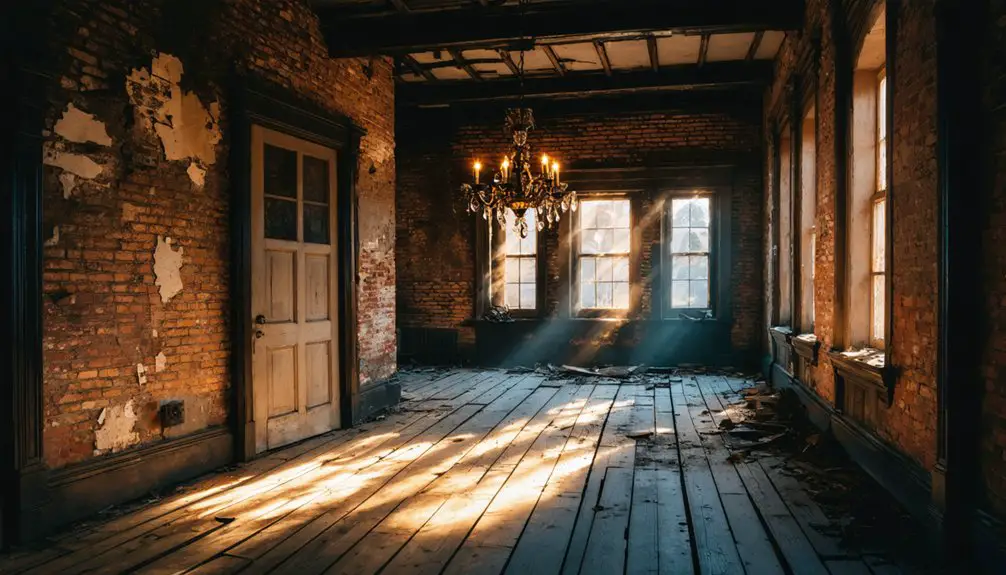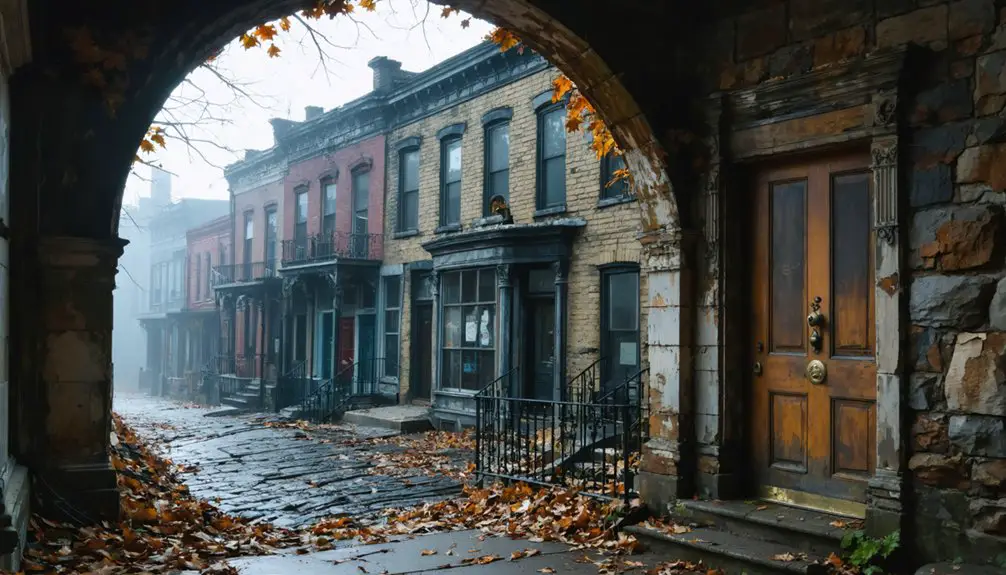You won’t find a ghost town in Marietta, PA, but rather a vibrant riverside community where history meets the supernatural. Since its 1804 founding, this town has survived 37 floods and Civil War destruction while preserving landmarks like the haunted Railroad House Inn and Shank’s Tavern, home to “The Lady in Black.” The Chickies Historic District showcases preserved architecture from the 1800s, while local ghost stories and paranormal activity keep the past eerily present.
Key Takeaways
- Marietta is not a ghost town but a thriving historic community that has continuously adapted and preserved its architectural heritage since 1812.
- Despite facing 37 floods since 1889 and Civil War damage, Marietta maintains an active population and successful preservation programs.
- The town features numerous operational historic buildings, including the Railroad House Inn from 1823 and the Market House from 1816.
- Marietta Restoration Associates, formed in 1965, actively preserves endangered properties and maintains the town’s historic character through adaptive reuse.
- The Chickies Historic District remains populated and listed on the National Register of Historic Places, with historic buildings serving modern purposes.
The Birth and Early Days of Marietta (1804-1812)
While trade along the Susquehanna River had long drawn settlers to the area, Marietta’s formal beginning emerged from two adjacent settlements in the early 1800s.
You’ll find the town founding began when David Cook’s son established New Haven on the east end in 1803, while James Anderson IV laid out Waterford on the west end in 1804.
These boom towns grew from land that Robert Wilkins and Reverend James Anderson had owned since the early 1700s.
The development pattern was similar to Ohio’s Yankee settlements which were rapidly expanding during this same period.
In 1812, the unified town of Marietta incorporated, establishing itself as a significant settlement and promptly raising soldiers for the War of 1812.
Civil War’s Devastating Impact on Local Architecture
Marietta’s growth from its early settlements was dramatically interrupted by the Civil War’s destructive force on local architecture. You’d have witnessed the devastating loss of the covered bridge to Columbia, as locals deliberately dismantled and burned it to stop Confederate advances across the Susquehanna. General Couch ordered strategic explosive placement on key bridge sections to prevent enemy forces from crossing. This war damage transformed the town’s infrastructure and daily life.
Yet from destruction came renewal. You’ll find evidence of architectural evolution in the identical “Arcade Row” homes built after 1865, and the rare Italianate Victorian-styled Musselman/Vesta Iron Furnace Center of 1868. The B. Frank Hiestand later purchased one of the town’s most prominent homes in 1888 for $5,000.
Local homes adapted too, with Victorian-era modifications like dormers and bay windows added to earlier Georgian structures. Today, the Chickies Historic District preserves these surviving structures, telling the story of Marietta’s resilience through architectural transformation.
Haunted Landmarks and Their Mysterious Tales
As you explore Marietta’s historical landmarks, you’ll encounter an intricate web of paranormal activity centered around three notable sites: the Railroad House Inn, the Kennesaw House, and the former Train Depot.
Each location carries its own haunted experiences, from the playful Victorian girl and flirtatious Annie at the Railroad House to the echoing voices of Civil War soldiers at Kennesaw House. The historic inn, constructed in 1823, originally provided lodging for weary canal workers and travelers along the waterfront. Many spirits emerged after Northern troops occupied the area extensively during the war.
The Train Depot continues to yield ghostly encounters, particularly involving spirits of fallen soldiers and a mysterious conductor.
- Room #6 at Railroad House Inn stands as the epicenter of unexplained phenomena
- Civil War hospital sites harbor the strongest paranormal activity
- Historical trauma from wartime occupation manifests in present-day hauntings
- Multiple witnesses report consistent patterns of supernatural events
- Each landmark preserves distinct spirits with documented backstories and behaviors
The Lady in Black: Shank’s Tavern’s Eternal Resident
If you visit Shank’s Tavern in Marietta, you’ll find yourself stepping into the domain of Barb Hauer, known as “The Lady in Black,” who managed the establishment between 1865 and 1885.
Her spirit, often spotted in period-appropriate black dress near the staircase and upstairs window, continues to keep watch over the tavern she once ran during its rougher days.
Modern ghost hunters regularly document unusual activity at this 1814 establishment, consistently attributing their findings to the watchful presence of the Lady in Black, who’s become an integral part of the tavern’s identity. During Prohibition, the tavern operated as a covert speakeasy, cleverly avoiding detection by law enforcement. The tavern’s current owner Bob Shank often shares these haunting tales with curious patrons who visit this historic Lancaster County landmark.
Historical Tavern Haunting Origins
Located at the corner of South Waterford and West Front Streets, Shank’s Tavern has cultivated more than just its reputation as Lancaster County’s oldest operating bar – it’s become the eternal home of a mysterious spectral resident known as “The Lady in Black.”
Since its establishment in 1814 by riverboat captain James Stackhouse, the tavern’s rich history of serving diverse patrons, from canal workers to GIs, has intertwined with decades of unexplained phenomena and ghostly encounters.
The tavern’s vintage architecture, with its original wood wainscoting and historic fixtures, provides the perfect backdrop for the supernatural tavern lore that’s developed over two centuries of ghost sightings. Current owner Bob Shank frequently engages patrons with stories of unexplained occurrences while serving drinks at the historic establishment.
The establishment’s resilience through challenging times was demonstrated when it managed to survive a fourteen-month closure during the COVID-19 pandemic.
- Original 1814 structure retains atmospheric elements that amplify paranormal activity
- Served as a speakeasy during Prohibition, adding layers of secrecy to its history
- Multiple ownership changes may have contributed to lingering spiritual energy
- Historic gathering place for soldiers, workers, and locals who never truly left
- Unexplained events experienced by staff and patrons continue to this day
Modern Ghost Hunt Encounters
Through decades of methodical ghost hunting investigations at Shank’s Tavern, The Lady in Black has emerged as one of Lancaster County‘s most documented spectral residents.
You’ll find her haunting signature spots throughout the historic building – hovering near the top of the staircase, lingering by the ladies’ room, or standing sentinel at the upstairs window overlooking Marietta’s streets.
Multiple paranormal research teams have attempted to make contact, documenting unexplained phenomena that align perfectly with eyewitness accounts.
While wearing her distinctive black dress, she appears silently during investigations, vanishing just as mysteriously.
Regular patrons continue sharing their personal paranormal experiences, adding to the tavern’s supernatural legacy.
Despite countless investigations, she remains elusive, keeping ghost hunters returning to this historic Pennsylvania landmark.
Preserving History: From Floods to Restoration

You’ll find evidence of Marietta’s resilience in the high-water marks at Shank’s Tavern, where the devastating floods of 1936 and 1972 left their permanent reminders.
The community’s determination to preserve its heritage shines through the work of Marietta Restoration Associates, founded in 1965 to protect the town’s historic architecture through innovative programs like the Candlelight Tour of Homes.
From the restored Sultzbach/Rinehart House to the Historic Marietta Theatre, you’re walking through living proof of a town that refused to let repeated floods wash away its rich architectural legacy.
Community Rebuilds After Disasters
Despite facing numerous devastating floods throughout its history, including the Great Ice Flood of 1904 and Hurricane Agnes in 1972, Marietta’s community has demonstrated remarkable resilience in preserving its historic structures.
You’ll find evidence of community resilience in how residents transformed disaster recovery into preservation opportunities. The Marietta Restoration Associates, formed in 1965, spearheaded initiatives to save endangered properties through revolving fund projects, while business owners like those at Shank’s Tavern adapted rather than abandoned their historic buildings.
- Railroad House Inn survived multiple floods, transforming its flooded cellar into a thriving pub
- 37 documented floods since 1889 haven’t broken the community’s spirit
- Innovative flood mitigation features installed in storm grates
- Historic buildings repurposed to maintain community vibrancy
- Preservation efforts retain original architecture while adapting to modern needs
Historic Architecture Endures Time
While Marietta’s historic buildings have weathered countless challenges, their architectural legacy stands as a tribute to meticulous preservation and adaptation.
You’ll find remarkable examples of historical craftsmanship in the 1814 Federal-style home with its 17 fireplaces and the 1835 Erisman House’s symmetrical Georgian features. Despite devastating losses during the Civil War, architectural resilience shines through in structures like the Market House (1816) and Town Hall (1847).
Since 1965, Marietta Restoration Associates has championed the protection of these architectural treasures.
They’ve seamlessly integrated modern amenities like natural gas heating while maintaining authentic period details. From log and stone construction of the 1700s to Victorian-era additions, each building tells a story of evolving design, technology, and community determination.
A Living Heritage Unlike Pennsylvania’s True Ghost Towns
Although many Pennsylvania ghost towns have succumbed to abandonment and decay, Marietta stands apart as a thriving community that successfully preserves its historical character.
You’ll find a vibrant mix of heritage tourism and community engagement, where historic buildings serve modern purposes while maintaining their architectural integrity. The town’s Chickies Historic District, listed on the National Register of Historic Places, showcases both residential and commercial importance.
Marietta’s historic architecture bridges past and present, with protected landmarks and districts serving both tourism and daily community life.
- The Railroad House Inn (1823) demonstrates successful adaptive reuse as a modern hospitality venue
- Historic neighborhoods like Irishtown and Moravian Town remain active residential areas
- The Market House (1816) and Town Hall (1847) continue serving civic functions
- Local preservation groups actively protect and restore architectural heritage
- Historic homes maintain their original character while housing current residents
Frequently Asked Questions
What Caused the Name Change From Waterford to Marietta in 1812?
You’ll find the name origin stems from when James Anderson and David Cook united Waterford and New Haven under one charter, creating historical significance through legislative action that birthed Marietta’s identity.
How Many Documented Paranormal Investigations Have Been Conducted at Railroad House Inn?
You’ll find no exact count of documented investigations, but the Railroad House Inn has hosted multiple paranormal activity studies, with at least one major ghost-hunting team capturing EMF spikes and spirit communications.
Are There Guided Ghost Tours Available Through Historic Downtown Marietta?
As shadows lengthen across cobblestone streets, you’ll find guided ghost tours aren’t currently available in downtown Marietta, though you’re free to explore the area’s ghostly encounters and historical significance independently.
What Native American Tribes Originally Inhabited the Marietta Area?
You’ll find that the Susquehannocks were the primary tribe in this area, leaving tribal artifacts along the Susquehanna River. Native American history shows they dominated the region until European diseases devastated their population.
How Many Original Pre-Civil War Buildings Still Remain in Marietta Today?
Time stands still in stone and wood. You’ll find hundreds of pre-Civil War buildings still standing today, thanks to preservation efforts that protected historic architecture through the Marietta Historic District’s 373 contributing structures.
References
- https://www.marietta.com/mariettas-haunted-history
- https://www.darkwhimsicalart.com/blogs/news/the-haunted-railroad-house-inn-in-lancaster-pa
- https://unchartedlancaster.com/2025/08/10/tales-from-the-taproom-the-spectral-legacy-of-shanks-tavern/
- https://pabucketlist.com/the-rise-and-fall-of-centralia-pas-toxic-ghost-town/
- http://www.mariettarestoration.org/history.html
- https://lancasterhistory.org/images/stories/JournalArticles/vol11no7pp252_257_163607.pdf
- https://www.etown.edu/programs/honors/files/Colonel James Martha Duffy Manse.pdf
- https://en.wikipedia.org/wiki/History_of_Ohio
- http://www.colonialsense.com/Architecture/Towns/Marietta
- https://www.mariettarestoration.org/2014-pictorial-review1.html



